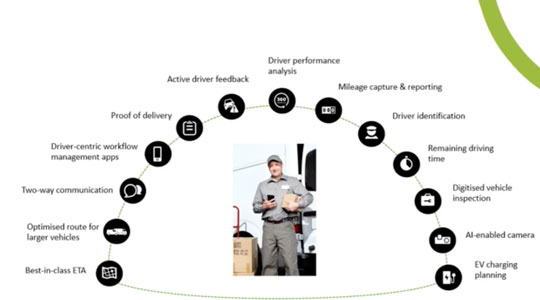
About the Author:
David Crangle is Head of Fleet Sales and Account Management for Simplicity Group based in Ireland and Northern Ireland. David primarily focuses on building new relationships and demonstrating how the right system can transform your fleet. With a wealth of experience working with HGV, bus and Coach and LCV fleets,David takes pride in staying at the forefront of emerging trends and technologies.
We return for part 2 of our 2-part series covering the first steps to Decarbonisation. If you missed the first one, you can find it here.
We teamed up recently with Anaeko covering Sustainability within the transport sector. During the discussion, our Head of Sales, David Crangle, shared insights on fleet decarbonisation. This covers the initial steps towards decarbonisation and strategies companies can implement even before electrifying their fleets.
Read part 2 of our 2-part series covering Fleet Decarbonisation below:
Picking up from where we left off, I intend to use this section to explore how trailers can adopt basic principles under the new trailer legislation. This can lead to significant progress in decarbonisation while also saving money.
Optimising Job Efficiency
Fleets should focus on completing tasks with less fuel consumption. This involves enhancing planning processes and route efficiency. A key strategy is implementing truck-specific route mapping instead of relying on generic telematics mapping systems.
Truck-specific mapping considers vehicle dimensions like height, width, and length, ensuring that routes are tailored to each vehicle’s specifications. This means planners can confidently select routes, knowing that factors such as low bridges are considered, simplifying their daily decision-making processes.
Now, let’s delve into the aspect of trailers and the upcoming legislation set to take effect this year.
Trailers and New Legislation
The end of June is set to see new legislation for trailers regarding brake testing. Under this, brake testing must be conducted with a 65% weight on the trailers. This requires trailers to be taken off the road four times a year for testing which can disrupt operations, increase mileage and fuel consumption for the fleet.
However, with the advent of new systems, there is a solution in sight. These systems allow for connectivity and provide critical data in real-time. Some customers have already transitioned to trailer management systems, enabling them to monitor live loads, optimise journey efficiency by maximising load capacity, and address maintenance issues promptly.
This shift towards proactive maintenance is facilitated by receiving live maintenance fault codes, allowing garages to anticipate and address issues before they escalate. Consequently, vehicles only need to be taken off the road for brake testing once a year, reducing the frequency of disruptions by 75%.
While there are costs associated with testing and transporting vehicles to test centres, it is worth noting that the new legislation mandates testing with loaded trailers. This change may result in more trailers failing initial tests and necessitating retests. Despite these challenges, the implementation of these systems presents tangible benefits such as reduced mileage, improved driver efficiency, and decreased fuel consumption and CO2 emissions, offering immediate opportunities for optimisation.
Example: A fleet comprising 500 trailers conducted a cost analysis and found significant savings. They determined that implementing these systems to extract data directly from the trailers resulted in savings of £1000 per vehicle. When extrapolated, these savings translate into substantial reductions in fuel costs, CO2 emissions, and overall decarbonisation efforts, effectively lightening the fleet’s environmental footprint.
What can I do with the data I have now?
It’s essential to start by assessing your current situation and resources, and then making improvements within the business, internal processes, and with drivers and management.
Consider a typical day for a driver. With telematics, you can now efficiently manage customer requests, dispatch jobs to drivers, provide a real-time estimated time of arrival (ETA), and send notifications to customers regarding arrival times that are realistic and accurate, minimising unnecessary rerouting.

Telematics software is tailored to each vehicle, ensuring efficient mileage management for both the vehicle and customers. Additonally, CO2 reports can be made readily available.
A significant advancement is the ability for systems to provide active feedback to drivers in real-time. This eliminates the need for regular in-person meetings. While periodic reviews are still valuable, real-time feedback enables immediate adjustments and improvements.
Regarding decarbonisation efforts, the focus is on understanding the current vehicle fleet, extracting relevant data, and leveraging available tools and systems to optimise performance and reduce environmental impact.
Conclusion
In today’s transport and logistics landscape, we have a multitude of systems: planning systems, transport management software, telematics, and maintenance systems. But the crucial question is: Do they all communicate effectively?
We ponder whether these systems collaborate seamlessly toward the common goal of achieving efficient fleet management. For instance, when generating fuel reports at the end of the year, the last thing you want is to spend weeks sifting through data from various sources, dealing with discrepancies in mileage and inaccuracies in fuel usage.
By integrating these systems, we eliminate these concerns. We ensure that you have access to real-time, reliable data, enhancing efficiency and accuracy. This integration also extends to environmental considerations, aligning with our eco-conscious initiatives.
This approach allows us to not only provide accurate vehicle data but also seamlessly integrate with other systems like transport management and maintenance systems, ensuring that data flows smoothly to where it’s needed.
In essence, this integrated approach forms the foundation for embarking on the decarbonisation journey today, facilitating informed decision-making and sustainable practices.
Why Choose Simplicity?
At Simplicity Group, a unique level of service and support lies at the core of our business. Our account managers are dedicated to supporting their client’s reach and exceeding their expectations. Our customers are at the forefront of what we do, and we believe we can offer a competitive price and a better service than any other provider.

